Explore Lan Ha Bay - North Vietnam Travel, Asia
Tucked away on the southeastern edge of Cat Ba Island, Lan Ha Bay is a dazzling mosaic of emerald waters, hidden beaches, and towering limestone karsts. Often called the “quiet sister” of Halong Bay, it offers the same breathtaking scenery without the tourist crowds. Here, over 300 islets and unspoiled coves create a paradise for kayakers, nature lovers, and those seeking authentic cultural encounters. This is where the rhythm of the sea shapes daily life, and where travelers can slow down to embrace Vietnam’s coastal charm.
Population: As a part of Ha Long Bay, Lan Ha Bay is home to a small population, primarily concentrated in Viet Hai village, which has a population of around 300 people.
Economy: Lan Ha Bay’s economy is closely tied to tourism, fishing, and aquaculture. The bay attracts visitors with its scenic beauty, supporting hotels, boat tours, and local services. Fishing and seafood farming, especially oysters and squid, provide income for coastal communities. Eco-tourism and sustainable aquaculture are increasingly promoted to balance economic growth with environmental protection.
Landmarks: Famous for the Monkey Island, Dark & Bright Cave, and the Nam Cat Island.
Vietnam
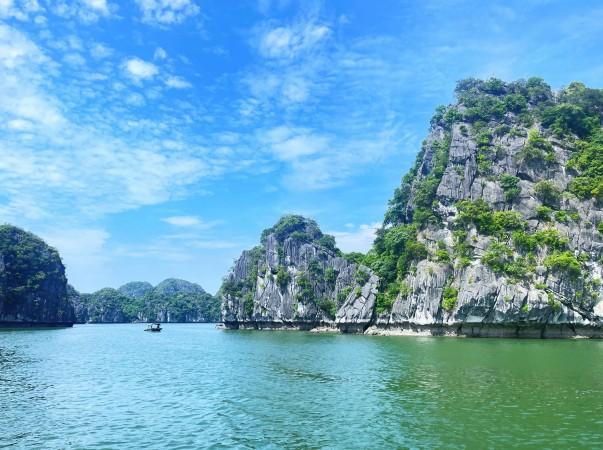
Overview of Lan Ha Bay
History & Cultural Influence
For centuries, Lan Ha Bay has been home to fishing communities whose lives revolve around the tides. Cai Beo Floating Village, believed to date back thousands of years, is a living testament to Vietnam’s maritime heritage. Influenced by both Vietnamese coastal traditions and the seafaring culture of the Gulf of Tonkin, the bay’s heritage blends practicality with beauty. They reflect a deep respect for nature, a principle now embraced in the bay’s growing eco-tourism initiatives.
Interaction with The Locals
One of Lan Ha Bay’s greatest treasures isn’t carved from stone or shaped by waves—it’s the people. Visiting Viet Hai Village or the floating homes of Cai Beo offers a rare chance to see island life up close. Here, smiles come easily, and hospitality feels effortless.
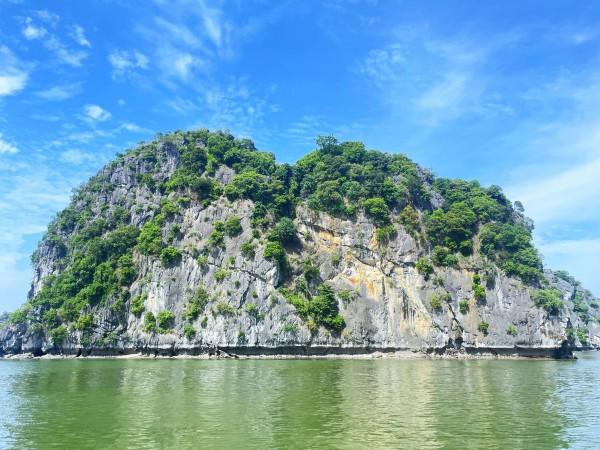
Top Attractions in Lan Ha Bay
Monkey Island
Just a 10-minute boat ride from Cat Ba Island, Monkey Island is home to friendly macaques that often roam the beach and the treeline. While they add charm, keep snacks tucked away to avoid mischief. The island’s real reward is its short but steep hike to a rocky summit. From here, panoramic views stretch across Lan Ha Bay’s emerald expanse.
Dark & Bright Cave
These twin caves are among the most photographed spots in the Gulf of Tonkin. The Bright Cave opens into a sheltered lagoon where sunlight dances on jade waters, perfect for leisurely kayaking. The Dark Cave, by contrast, is a mysterious paddle through shadowed passages, offering a cooler, more tranquil experience. Local guides often share legends tied to the caves, adding cultural depth to the adventure.
Nam Cat Island
A secluded paradise with pristine sands and calm shallows, Nam Cat is a peaceful escape from busier routes. Wooden bungalows dot the shoreline, offering the chance to wake up to sunrise over the bay. The surrounding waters teem with marine life, making it an ideal spot for snorkeling and swimming in crystal-clear conditions.
Ba Trai Dao Beach
Named for its three peach-shaped limestone islets, Ba Trai Dao is best visited during low tide when white sands emerge between the rocks. The shallow, calm waters make it a safe and inviting place for kayaking or paddleboarding. Legend says the islets were formed from peaches gifted by the Jade Emperor, giving the beach a touch of romance and folklore.
Cat Dua Island
Known for its powdery sand and colorful coral reefs, Cat Dua offers both relaxation and adventure. Snorkelers can spot schools of tropical fish and vibrant corals just meters from shore. Inland, the island’s shaded trails lead to small viewpoints, while beachfront cafés serve fresh coconuts and seafood snacks, perfect for a mid-day break.
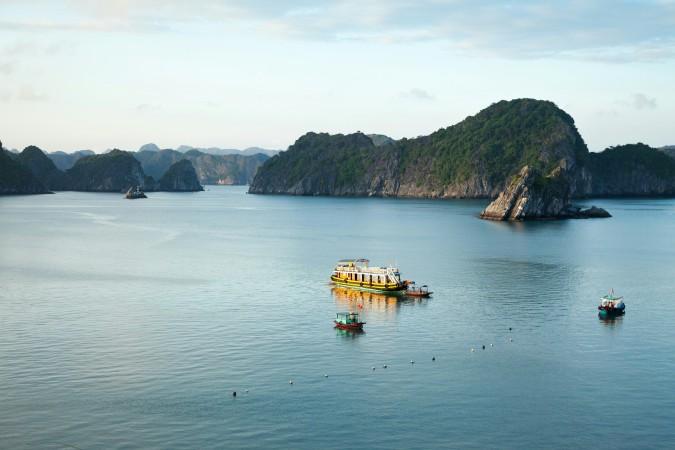
Must-Try Dishes in Lan Ha Bay
- Grilled Squid: Freshly caught squid, marinated with garlic, lime, and chili, is grilled over charcoal until smoky and tender. The natural sweetness of the squid pairs perfectly with a dipping sauce of lime juice, salt, and pepper. Many floating restaurants in Cai Beo Village serve it straight from the boat to your table.
- Horseshoe Crab Dishes: A true coastal delicacy, horseshoe crab is often stir-fried with lemongrass and chili or cooked in a fragrant tamarind sauce. Its unique texture makes it a must-try for adventurous foodies.
- Geoduck Clam: Known for its sweet, juicy meat, the geoduck clam is a Lan Ha Bay specialty. It’s often steamed with ginger or served sashimi-style for the freshest taste. The dish is prized for both its flavor and its rarity, making it a highlight of local dining.
- Fresh Oysters: Harvested from the bay’s calm, clean waters, Lan Ha’s oysters are exceptionally plump. You can enjoy them raw with a squeeze of lime, grilled with scallion oil, or baked with cheese for a modern twist.
- Jellyfish Salad: A refreshing mix of blanched jellyfish, green mango, herbs, and roasted peanuts, dressed in a tangy fish sauce. Light yet full of flavor, it’s a perfect appetizer on a warm day and a great introduction to Vietnam’s coastal cuisine.
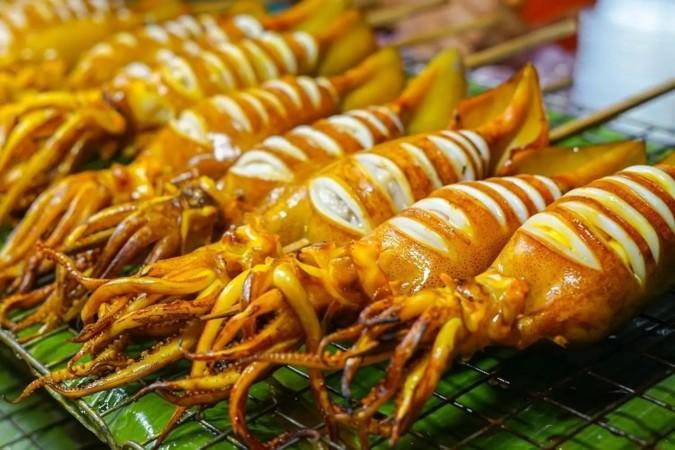
Festivals & Local Celebrations
Fishermen’s Festival
Held in coastal villages like Cai Beo, this festival is a vibrant prayer for safe voyages and bountiful catches. It features boat races, traditional music, and ritual offerings to the sea gods. Locals dress in bright costumes, and the air is filled with the beat of drums and the scent of incense. Travelers are often welcomed to join the celebrations, making it an unforgettable cultural encounter.
Lunar New Year
Tet Holidays in Lan Ha Bay blends Vietnam’s national holiday traditions with a maritime twist. Fishing boats are decorated with colorful flags, and families prepare seafood-rich feasts. Visiting during this national holiday offers a rare glimpse into the warmth of island hospitality, though travelers should plan ahead as ferry services can be limited.
Mid-Autumn Festival
On the islands, Mid-Autumn is marked by mooncakes, lanterns, and boat parades. Children carry star-shaped lanterns along the docks, while the shimmering moon reflects on the calm bay waters. It’s a magical time to be in Lan Ha Bay, especially for families and photographers.
Local Boat Races
Often tied to seasonal celebrations, these races showcase the strength and skill of local fishermen. Teams paddle long wooden boats through the bay’s waters, cheered on by villagers and visitors alike. The atmosphere is electric, blending friendly competition with a sense of unity.
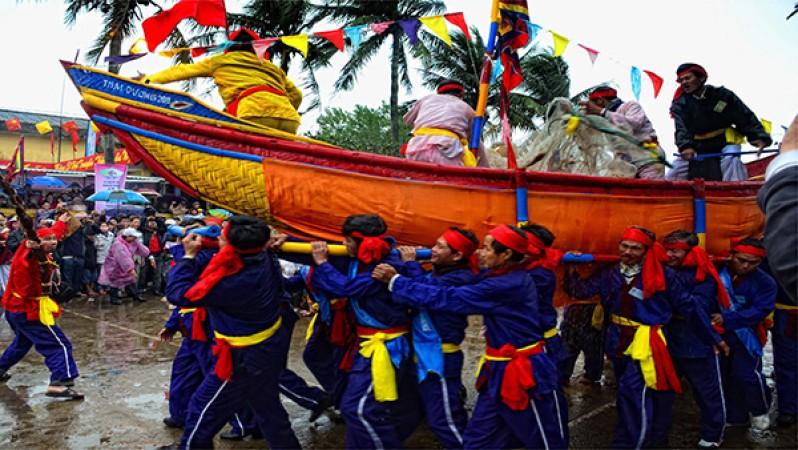
What to Do in Lan Ha Bay
- Kayaking Through Hidden Lagoons: With over 300 limestone islets, Lan Ha Bay is a kayaker’s dream. Paddle into secluded lagoons, glide beneath arching rock formations, and explore narrow waterways that larger boats can’t reach. Popular spots include Dark & Bright Cave and Ba Trai Dao.
- Snorkeling and Diving: Crystal-clear waters and thriving coral reefs make snorkeling a must-do. Swim alongside schools of tropical fish, spot vibrant corals, and see marine life up close near Cat Dua Island and Nam Cat Island.
- Rock Climbing: Sheer limestone cliffs rising from the sea attract climbers from around the world. Routes vary from beginner-friendly to expert-level challenges, with some climbs offering breathtaking views right from the cliff face.
- Trekking in Cat Ba National Park: Just beyond the bay lies Cat Ba National Park, home to rare wildlife like the golden-headed langur. Trails lead through dense jungle, past waterfalls, and to panoramic viewpoints overlooking the bay.
- Overnight Cruises: For a slower, immersive experience, board an overnight cruise. These journeys combine sightseeing with on-deck dining, sunset cocktails, and starlit skies. Options range from budget-friendly boats to luxury vessels.
Shopping in Lan Ha Bay
- Cat Ba Market: The main market on Cat Ba Island bustles with vendors selling fresh seafood, tropical fruits, and homemade sauces. Early mornings are the most vibrant, as fishermen bring in their daily catch.
- Seafood Products: Take a piece of the bay home with dried squid, seaweed, or locally made fish sauce. These products are staples in island kitchens and make authentic gifts for food lovers.
- Pearl Jewelry: The calm waters of the Gulf of Tonkin are ideal for pearl farming. Many small workshops sell handcrafted pearl necklaces, earrings, and bracelets, each piece unique in shape and luster.

Weather in Lan Ha Bay: Best Time to Visit
- Spring (March – April): Fresh breezes, gentle sunlight, and blooming flowers along the coast make spring an excellent choice for outdoor activities. Visibility is great for scenic boat rides and coastal hikes.
- Summer (May – August): This is the warmest time of year, with temperatures often ranging from 28°C to 32°C. It’s perfect for swimming, but occasional tropical storms can occur in July and August. Booking flexible travel dates is wise.
- Autumn (September – November): Mild and calm, autumn offers some of the best sailing conditions. The scenery is at its most vibrant, and the weather is comfortable for trekking in Cat Ba National Park.
- Winter (December – February): Cooler temperatures of 15°C to 20°C and misty mornings give the bay a mysterious, romantic atmosphere. While swimming is less popular, it’s a wonderful time for photography and quiet exploration.
Best Time to Visit Lan Ha Bay
The most pleasant months are April to June and September to November. During these periods, skies are clear, humidity is moderate, and the bay’s waters shimmer under the sun, ideal for kayaking, snorkeling, and photography.
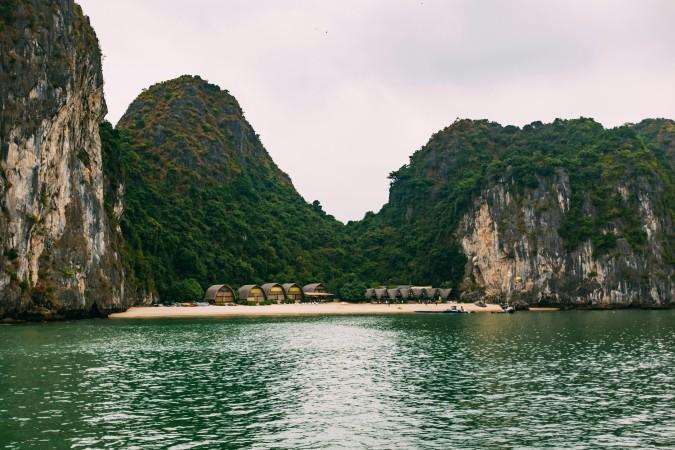
Essential Travel Information
Getting Around Lan Ha Bay
- Local Boats: Wooden fishing boats and small ferries are ideal for short trips between islands and floating villages.
- Kayaks: Perfect for exploring secluded lagoons and caves at your own pace.
- Bicycle Rentals: On Cat Ba Island, cycling to villages like Viet Hai offers a scenic, eco-friendly way to explore.
- Motorbike Rentals: For more flexibility on Cat Ba, motorbikes are available for daily hire.
ATM & Banking Services
While Lan Ha Bay itself is a natural escape, practicalities like cash access and payments are important to plan ahead. The bay’s main access point, Cat Ba Island, has the bulk of the financial services. Most ATMs are located in Cat Ba Town and accept international cards such as Visa and MasterCard. However, when you’re in floating villages like Cai Beo and Viet Hai, bring cash with you.
Where to Stay in Lan Ha Bay
- Luxury Cruises: Spend the night onboard a premium vessel with private balconies, fine dining, and guided excursions. Popular names include Heritage Line and Orchid Cruises, which combine comfort with panoramic views of the bay.
- Mid-Range Hotels: Cat Ba Town offers a variety of three- and four-star hotels within walking distance of the harbor. Many have sea-view rooms, rooftop pools, and on-site restaurants serving fresh seafood.
- Floating Homestays: For a truly immersive experience, stay with a fishing family on a floating house in the bay. Guests can join fishing trips, learn traditional cooking, and wake up to the gentle sound of waves.
- Eco-Lodges: Nestled in nature, eco-lodges on secluded beaches and small islands offer solar-powered rooms, locally sourced meals, and minimal environmental impact.
Articles for you

Explore Yala National Park - Sri Lanka Travel, Asia
Tucked away in Sri Lanka’s southeastern corner, Yala National Park is where wild nature meets deep tradition. Known worldwide for its leopard population, the park is also home to elephants, sloth bears, crocodiles, and hundreds of bird species. Beyond wildlife, Yala opens doors to a cultural landscape dotted with ancient temples, Buddhist ruins, and coastal villages. For travelers seeking more than just a safari, Yala offers a chance to explore eco-tourism, local communities, and sacred heritage sites.
Population: The Yala National Park area doesn’t have a human population.
Economy: The economy around Yala National Park thrives on a blend of eco-tourism, agriculture, and local services. Safari tours, eco-lodges, and cultural experiences drive steady income for nearby towns like Tissamaharama and Kataragama, supporting thousands of families.
Landmarks: Famous for Block I of Yala and wildlife encounters, including elephants, sloth bears, crocodiles, and exotic bird species.

Explore Galle - Sri Lanka Travel, Asia
Nestled on Sri Lanka’s southern coastline, Galle is a vibrant city where history meets the sea. Its cobbled streets, colonial architecture, and serene beaches make it a must-visit destination for travelers seeking a blend of culture, adventure, and relaxation. A UNESCO World Heritage site, Galle captivates visitors with its Dutch Fort, bustling markets, and friendly locals. Whether you’re exploring the ramparts at sunset or savoring fresh seafood by the shore, Galle promises an unforgettable journey into Sri Lanka’s heritage.
Population: Approximately 113,000 in 2023.
Economy: Galle’s economy thrives on tourism, trade, and fisheries. The city’s historic fort, colonial architecture, and coastal charm draw thousands of international visitors each year, making tourism its main economic driver. Fishing remains vital for local livelihoods, supplying fresh seafood across the region.
Landmarks: Famous for the Galle Fort, Dutch Reformed Church & Maritime Museum, and Unawatuna Beach.

Explore Bentota - Sri Lanka Travel, Asia
Nestled along Sri Lanka’s southwestern coast, Bentota is a tropical paradise that blends golden beaches, vibrant culture, and thrilling adventures. Famous for its calm waters, luxury resorts, and scenic river estuary, Bentota has become a top destination for travelers seeking both relaxation and authentic experiences. From serene beach walks at sunrise to adrenaline-pumping water sports, this coastal town offers a perfect balance of leisure and exploration. With its proximity to Colombo and Galle, Bentota is easy to reach, making it an ideal stop for both short escapes and extended holidays.
Population: Approximately 37,000 in 2023.
Economy: Bentota’s economy thrives mainly on tourism, which drives local businesses such as hotels, restaurants, and wellness retreats. The town also benefits from fishing, coconut cultivation, and handicrafts like wood carving and batik textiles. Many residents rely on the growing demand for water sports and Ayurvedic treatments, making tourism the backbone of both income and employment in the area.
Landmarks: Famous for Bentota Beach, Bentota River Safari, and Kande Vihara Temple.

Explore Mirissa - Sri Lanka Travel, Asia
Mirissa is a charming coastal town on Sri Lanka’s southern shoreline. Known for its golden beaches, turquoise waters, and vibrant marine life, it has become a must-visit stop for travelers exploring the island. Many come for whale watching, surfing, and sunset views at Coconut Tree Hill, but Mirissa offers much more than postcard beauty. The fishing boats you see anchored by the bay carry generations of stories. Local traditions, delicious cuisine, and a laid-back rhythm of life shape every visitor’s experience.
Population: Approximately 4,700 in 2023.
Economy: Mirissa’s economy is largely shaped by its coastal location. Fishing has long been the backbone of local livelihoods, with generations relying on the Indian Ocean for income. In recent decades, tourism has become the main driver of growth, thanks to whale watching, surfing, and beachside hospitality.
Landmarks: Famous for Mirissa Beach, Coconut Tree Hill, and Parrot Rock Bridge.

Explore Nuwara Eliya - Sri Lanka Travel, Asia
Tucked away in the Central Highlands of Sri Lanka, Nuwara Eliya is often called “Little England”. With its rolling tea plantations, cool misty mornings, and colonial charm, this mountain town feels like a step into another world. Travelers come here to breathe fresh air, walk through flower gardens, sip the finest Ceylon Tea, and enjoy a pace of life far from the island’s busy cities. Whether you’re drawn by scenic landscapes, heritage architecture, or the warmth of its people, Nuwara Eliya is a destination that blends nature, culture, and history in perfect harmony.
Population: Approximately 781,000 in 2023.
Economy: Nuwara Eliya’s economy thrives mainly on tea production, as it sits in the heart of Sri Lanka’s central highlands, famous worldwide for Ceylon Tea. The city also benefits from a growing tourism industry, attracting visitors with its colonial charm, cool climate, and scenic landscapes.
Landmarks: Famous for Gregory Lake, Hakgala Botanical Garden, and Victoria Park.

Explore Sukau - Malaysia Travel, Asia
Nestled on the banks of the Kinabatangan River in Sabah, Malaysian Borneo, Sukau is a destination where wildlife, culture, and conservation come together. Known as one of Asia’s top spots for river safaris and eco-tourism, this quiet village offers a front-row seat to encounters with Bornean orangutans, pygmy elephants, proboscis monkeys, and exotic birdlife.
Population: Approximately 1,400 in 2019.
Economy: Sukau’s economy is shaped by its riverine location and natural resources. Traditionally, the Orang Sungai community relied on fishing, small-scale farming, and forest gathering for their livelihood. Today, the village has shifted toward eco-tourism, with river cruises, jungle trekking, and homestays providing income.
Landmarks: Famous for the Kinabatangan River cruises, Gomantong Caves, and Ox-bow lakes and wetlands.
